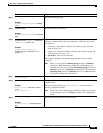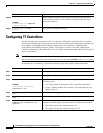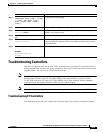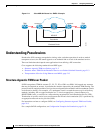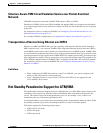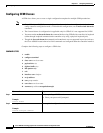
21-3
Cisco ASR 901 Series Aggregation Services Router Software Configuration Guide
OL-23826-09
Chapter 21 Configuring Pseudowire
Hot Standby Pseudowire Support for ATM/IMA
Structure-Aware TDM Circuit Emulation Service over Packet-Switched
Network
CESoPSN encapsulates structured (NxDS0) TDM signals as PWs over PSNs.
Emulation of NxDS0 circuits saves PSN bandwidth and supports DS0-level grooming and distributed
cross-connect applications. It also enhances resilience of CE devices due to the effects of loss of packets
in the PSN.
For instructions on how to configure CESoPSN, see Configuring Circuit Emulation Service over
Packet-Switched Network, page 21-14.
For a sample CESoPSN configuration, see Configuration Examples for Pseudowire, page 21-31.
Transportation of Service Using Ethernet over MPLS
Ethernet over MPLS (EoMPLS) PWs provide a tunneling mechanism for Ethernet traffic through an
MPLS-enabled Layer 3 core network. EoMPLS PWs encapsulate Ethernet protocol data units (PDUs)
inside MPLS packets and use label switching to forward them across an MPLS network. EoMPLS PWs
are an evolutionary technology that allows you to migrate packet networks from legacy networks while
providing transport for legacy applications. EoMPLS PWs also simplify provisioning, since the provider
edge equipment only requires Layer 2 connectivity to the connected customer edge (CE) equipment. The
Cisco ASR 901 implementation of EoMPLS PWs is compliant with the RFC 4447 and 4448 standards.
For instructions on how to create an EoMPLS PW, see Configuring Transportation of Service Using
Ethernet over MPLS.
Limitations
• When configuring an EoMPLS pseudowire on the Cisco ASR 901, you cannot configure an IP
address on the same interface as the pseudowire.
• Layer 2 Tunneling Protocol, version 2 and 3 (L2TPv2 and L2TPv3) is not supported on the
Cisco ASR 901 series routers.
Hot Standby Pseudowire Support for ATM/IMA
The Hot Standby Pseudowire Support for Inverse Multiplexing over ATM (IMA) feature improves the
availability of pseudowires by detecting failures and handling them with minimal disruption to the
service. This feature allows the backup pseudowire to be in a “hot standby” state, so that it can
immediately take over if the primary pseudowire fails.
A backup pseudowire is provisioned and corresponding entries are populated to hardware tables. When
the primary pseudowire goes down, the backup pseudowire is used to switch the packets.
This feature supports the following transport types:
• ATM AAL5 in VC mode
• ATM in VP mode
• ATM in port mode



